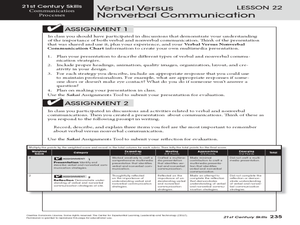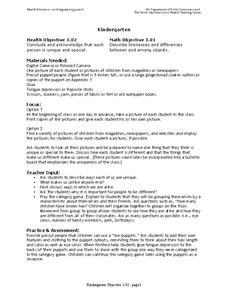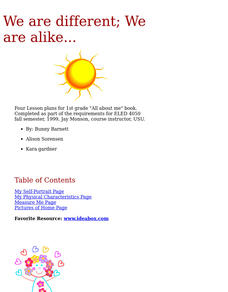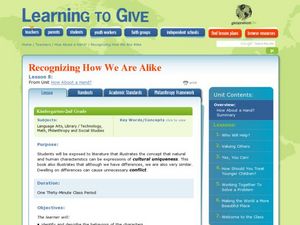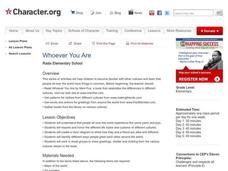Curated OER
Two Snails
In this two snails instructional activity, students observe and spot the differences between a picture of two families of snails and circle each one they find.
Curated OER
What Class Are You In?
Classifying animals has never been this much fun! Pupils discuss the animal groups, fish, reptiles, amphibians, mammals, birds, and also identify their characteristics. Then, they take pictures of animals and classify them in a group...
Curated OER
Introduce: Comparison and Contrast
Class discussions can really make concepts come to life. The class discusses the differences between compare and contrast, read a book, then talk about ways they can compare events or characters in the story. Good leading question are...
Museum of Disability
Don't Call Me Special
Introduce young learners to the idea of disabilities and making friends with children who are different than they are. Using Don't Call Me Special - A First Look at Disability by Pat Thomas, learners are guided through the new...
Curated OER
Animals and Humans
Students identify the functions of various body parts. They participate in the "Head, Shoulders, Knees, and Toes" song, draw a picture of themselves and other mammals, and create a traced outline of their body that they add features to....
Curated OER
Compare and Contrast
In this compare/contrast worksheet, students look at pictures of a chair and a cat and read about they are similar and different. Next, students fill in a graphic organizer about how these 2 things are alike and different.
Curated OER
What is a River?
Students study the various types of bodies of water: rivers, oceans, lakes and ponds. They observe models of each and then use clues to discuss how they are alike and different. They imagine they have found a new planet and draw a map...
Curated OER
Describing Family - Lesson Plan
Students describe their family in their new language French. They use adjectives, and proper gender. Then they describe how the family is alike and different.
Curated OER
Picture an Astronomer
Students create a drawing of what an astronomer looks like. They explore their own assumptions of those who work in the sciences.
Curated OER
Plant Groups
Compare different types of leaves in a science exploration. First, third graders identify common characteristics of various plants, such as daisies, fir needles, and cypress leaves. They then determine if the plants in each group are...
Perkins School for the Blind
Mix and Match
Sorting and matching are skills that have all kinds of applications. Learners with low, but useable vision work to match an object to an object, an object to a picture, and a picture to a picture. This will help them identify objects...
Curated OER
Double Jeopardy-Homophones
Second graders identify homophones as words that sound alike but have different meanings. They, given a pair of homophones, are to explain the meanings of the words using gestures, role playing, or drawing a picture with their partner.
Curated OER
Penguins Around the World
Students investigate penguins. In this Science lesson plan, students compare and contrast penguins to flying birds. Students use a Venn diagram to illustrate the differences and similarities of penguins and flying birds.
Curated OER
Periodic Table Basics Test
The periodic table of elements is a vital tool for all chemistry apprentices and professionals alike. Here is a chance for your beginning chemists to assess their understanding of the periodic table. They list element names, symbols,...
Curated OER
Verbal Versus Nonverbal Communication
Young scholars create a multimedia presentation. They will complete a verbal versus non-verbal communication chart to create a multimedia presentation which will include the different types of communication strategies. Then answer a...
Illustrative Mathematics
Security Camera
A different-than-normal problem that allows learners to practice their reasoning to find an answer. The problem bases itself off a graph drawing of a store that needs to install security cameras. The challenge is to find which placement...
Curated OER
Structure and Function of the Cell/Introduction to the Cell
So, this is not technically a worksheet, but rather a chapter of reading material, pictures, and diagrams introducing young biologists to the cell. Cell theory, diversity, size, and shape are described. The internal organization and...
Curated OER
I Am Special and You Are Special Too
Learners discover how everyone is special in his or her own way. In this character traits lesson, students demonstrate how they are special by drawing a picture or writing. Learners listen orally to the book We Are All Alike...We Are All...
Curated OER
I Am Special
Students conclude and acknowledge that each person is unique and special. In this I Am Special lesson plan, students compare their digital photograph to pictures of people in magazines to determine likenesses/differences. They describe...
Curated OER
Bug Watching
For this visual thinking worksheet, students first circle the four bug pictures (out of ten) that are exactly alike. Then students draw bugs that are the same or different according to the directions.
Curated OER
Look Alikes
Third graders compare and contrast the physical features of parents and offspring. In this life science lesson, 3rd graders classify a set of animal pictures according to their similarities. They share and explain their work in class.
Curated OER
We Are Different; We Are Alike........
First graders explain that everybody is unique in their own way by participating in this lively, art and language based series of lesson plans. They would greatly benefit from engaging in these plans in the beginning of the year as an...
Curated OER
Recognizing How We Are Alike
Young scholars explore the concept of social justice. In this service learning worksheet, students read The Sneeches in order to appreciate cultural uniqueness.
Curated OER
Whoever You Are
Students examine cultures, traditions, and feeling throughout cultures. For this cultural lesson, students use literature, maps, and cultural information to examine how people have universal feelings despite their different cultures and...
















